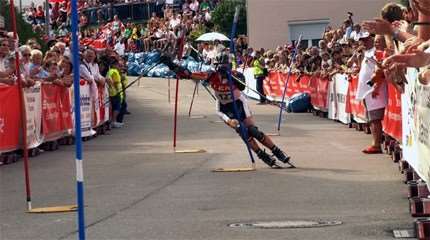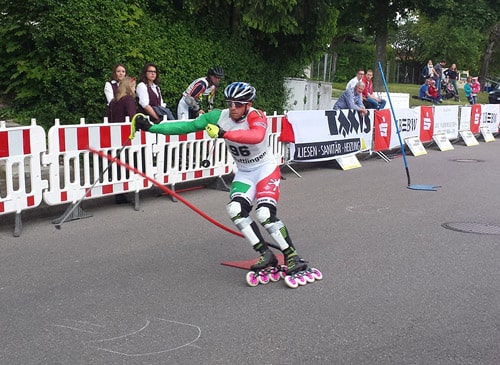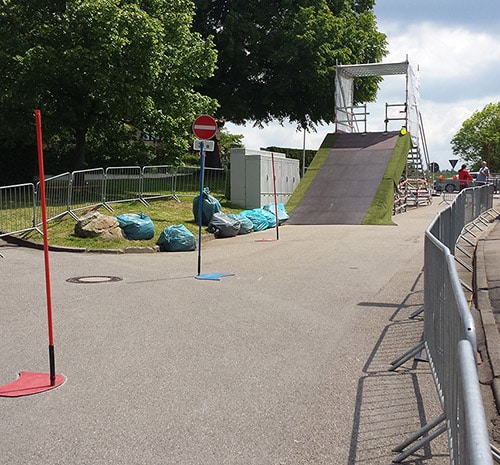What is Inline Alpine Skating?
The practice of inline alpine skating is meeting with increasing success in Europe and obtained its recognition by the FIRS in 2011. But what is this sport about?
Par alfathor

Three race formats

Inline Alpine Skating relates a lot to slalom on skis. Without snow during the summer time, the skaters have transposed their skiing in the snow to skating downhill on asphalt. The competitors race down hills equipped with bendable posts held by massive 15 kg metal plates.
The discipline obviously attracts the older skiers but also young thrill-seeker generations. Inline Alpine mixes speed and technique, in competition with opponents. Like Rollerskiing, it is a good method of training for competitors who prepare their winter season.
The evolution area
The start structure varies according to the profile of the course. The height of the launch ramp varies between 60 cm and 2 m. Against the clock, the time starts when the leg of the skater opens the start gate. The aim is to get the maximum speed before reaching the gates and find the good rhythm.
The inclination of the slope is between 6 and 15% to the max, with a smooth asphalt ground. The distance between the gates varies between 3 and 8 m. A run is made of 30 to 60 gates for a length varying between 150 and 250 m. The arrival area has to provide enough space to stop or be equipped with carpets to slow down the speed of the competitors.
Bales of straw can be placed on the critical spots to reduce the risks. The track must be at least 5 m wide. The international rules recommend to vary the space between the gates to break the course monotony.
Inline Alpine Slalom
In slalom, the skaters go for two runs.
- The aim is to make the best time as possible to win.
- The start is given with the command: ‘Ready — Set — Go!’. From then on, the skater has 10 seconds to go.
- Each missed gate is sanctioned by a penalty.
- The second run is kept for the best 50 men and women only. The list of skaters for the second run is annonced in-between the two runs.
Inline Alpine Giant Slalom
- The gates are made of two posts linked by a piece of cloth. In case of too hard a shock, the piece of cloth should be removed easily to avoid risks for the skater.
- The distance between the gates varies between 10 and 15 m.
- The number of gates varies between 20 and 35 and have two different colors.
- A giant slalom is made of bends of small, medium, and large radii. The skaters must have the possibility to choose their lines between the gates.
- The inclination of the slope must be between 6 and 10%.
- The rules recommend to avoid spacing between gates forcing the competitors to brake strongly.
- Competitors who miss a gate cannot go back and have to resume their run.
- The second run is kept only for the 50 best men and women. The list of skaters for the second run is announced in-between the two runs.
Inline Alpine Parallel Slalom
Skaters compete by pair. The two courses must be as identical as possible.
- The two course have different colors.
- Each course has between 20 and 25 gates.
- They are at least 6 meters apart.
- Qualifications are about doing the best time on one run for men and women. The 32 best skaters are qualified for the final phases.
- The start works with an electronic system activating the two start gates at the same time (just like in BMX and sometimes in SkateCross).
- The skaters switch courses for their second run.
Countries practicing Inline Alpine
The discipline meets with increasing success in Germany, Austria, Czech Republic, Italy, Latvia, Croatia, Japan, Switzerland, Slovakia, Spain, Poland, India…
Gear
The protective gear is close to that of downhill skating but in a lighter version. The skaters have BMX-type full face helmets, knee and elbow pads, gloves and above all shin guards to skate as close as possible to the posts and bump into them without getting hurt.
Moreover, the skaters use sticks like in skiing.
Types of skates
Skates with big wheels are very common since they give better inertia (over 100 m). Several different types of boots can be noticed: rigid with a high cut like in downhill skating for a maximum support and precision… or low cut boots like in speed skating!
Competitions

National competitions
Several countries organize national competitions, especially the ones mentioned above like Germany, Italy, Austria or Switzerland.
World Cup
The World Cup of Inline Alpine only affects two disciplines:
- Inline Alpine Slalom
- Inline Alpine Giant Slalom
A quota of skaters is given: 15 for each country… Except for the organizing country, that can register up to 35 competitors!
Each race gives points for the international ranking. The skater with the more points at the end of the season wins the World Cup of Inline Alpine. Only the two best races are taken into account.
The stages of the 2015 World Cup of Inline Alpine
- June 21st, 2015: Jirkov (CZE)
- July 26th, 2015: Pisogne (ITA)
- August 16th, 2015: Villablino (ESP)
- August 23rd, 2015: Bramberg (AUT)
- September 5th and 6th, 2015: Nemcicky (CZE)
Point distribution of the World Cup of Inline Alpine according to the ranking
|
Women |
Men |
||
|
Pos. |
Points |
Pos. |
Points |
|
1 |
100 |
1 |
100 |
|
2 |
80 |
2 |
80 |
|
3 |
60 |
3 |
60 |
|
4 |
50 |
4 |
50 |
|
5 |
45 |
5 |
45 |
|
6 |
40 |
6 |
40 |
|
7 |
36 |
7 |
36 |
|
8 |
32 |
8 |
32 |
|
9 |
29 |
9 |
29 |
|
10 |
26 |
10 |
26 |
|
11 |
24 |
11 |
24 |
|
12 |
22 |
12 |
22 |
|
13 |
20 |
13 |
20 |
|
14 |
18 |
14 |
18 |
|
15 |
16 |
15 |
16 |
|
16 |
15 |
16 |
15 |
|
17 |
14 |
17 |
14 |
|
18 |
13 |
18 |
13 |
|
19 |
12 |
19 |
12 |
|
20 |
11 |
20 |
11 |
|
21 |
10 |
21 |
10 |
|
22 |
9 |
22 |
9 |
|
23 |
8 |
23 |
8 |
|
24 |
7 |
24 |
7 |
|
25 |
6 |
25 |
6 |
|
26 |
5 |
26 |
5 |
|
27 |
4 |
27 |
4 |
|
28 |
3 |
28 |
3 |
|
29 |
2 |
29 |
2 |
|
30 |
1 |
30 |
1 |
The other international competitions
- The 2015 Senior World Championship took place in Nemcicky, Czech Republic.
- The 2015 Junior European Championship will be held on August 22nd in Bramberg, Austria.
- No country has been yet designated to host the 2016 Worlds.
- The 2017 Roller Games in Barcelona will host the Inline Alpine Worlds.
- In 2018, the Worlds will take place in Nagano, Japan.
The international bodies
Since 2011, Inline Alpine has been ruled by the International Federation of Roller Sports. Since January 1st, 2015 and the dissolution of the World Inline Alpine Committee (WIAC), the Comité International de Roller Alpine (CIRA) has taken over the management of the discipline. The CIRA has a member in the executive board of the FIRS but doesn’t have the right to vote. The voting right will be granted once 20 nations from 3 different continents practice Inline Alpine.
The CIRA organizes the international competitions such as the World Cups, the World Championships, and the junior and senior European Championships.
Videos
Useful links
See our page dedicated to the World Cup of Inline Alpine
Inline Alpine section on the FIRS website
Inline Alpine official ruleset
Photo gallery on the FIRS website
Translation: Chloe Seyres
Photos : FIRS – all rights reserved

Raja
16 août 2022 at 5 h 09 min